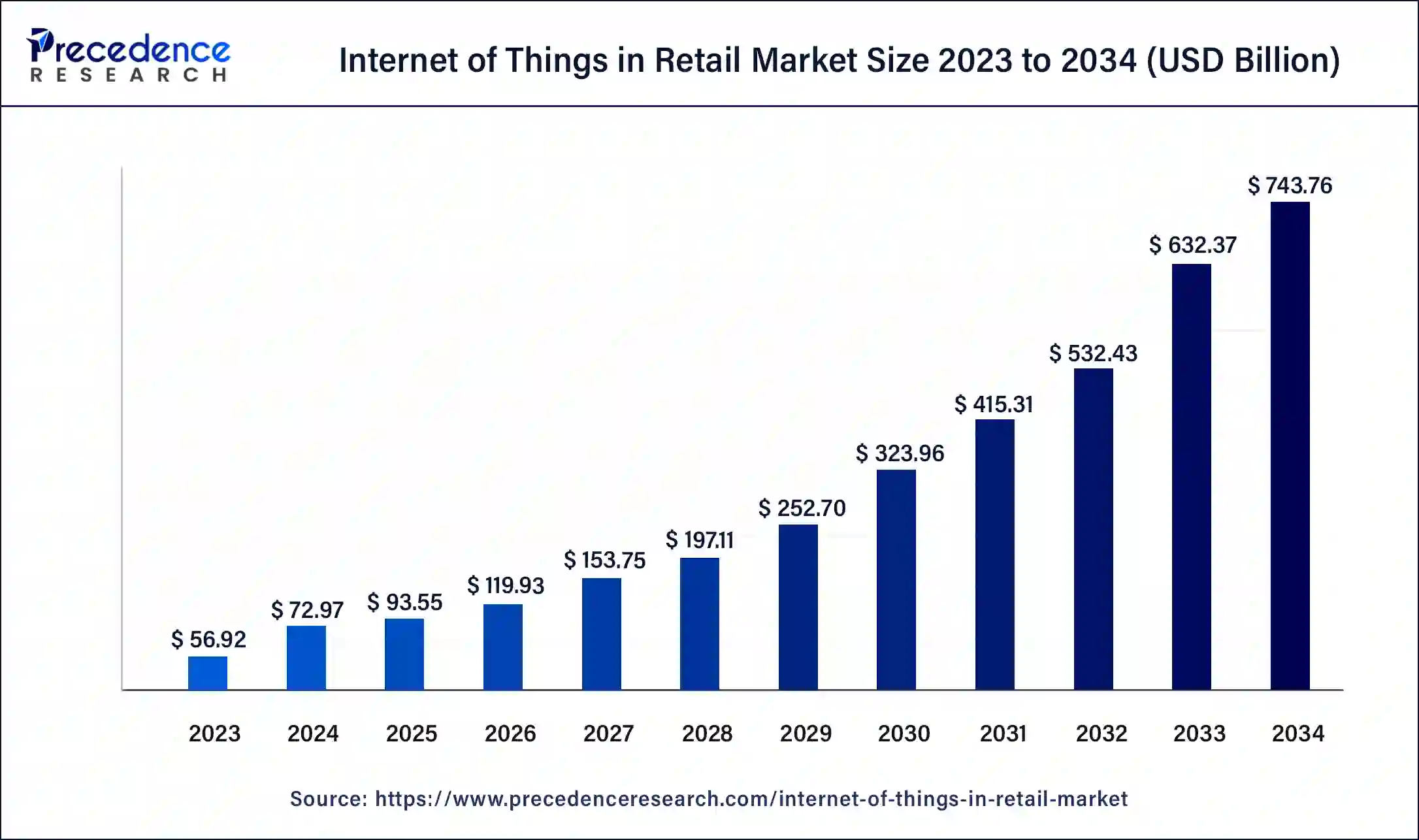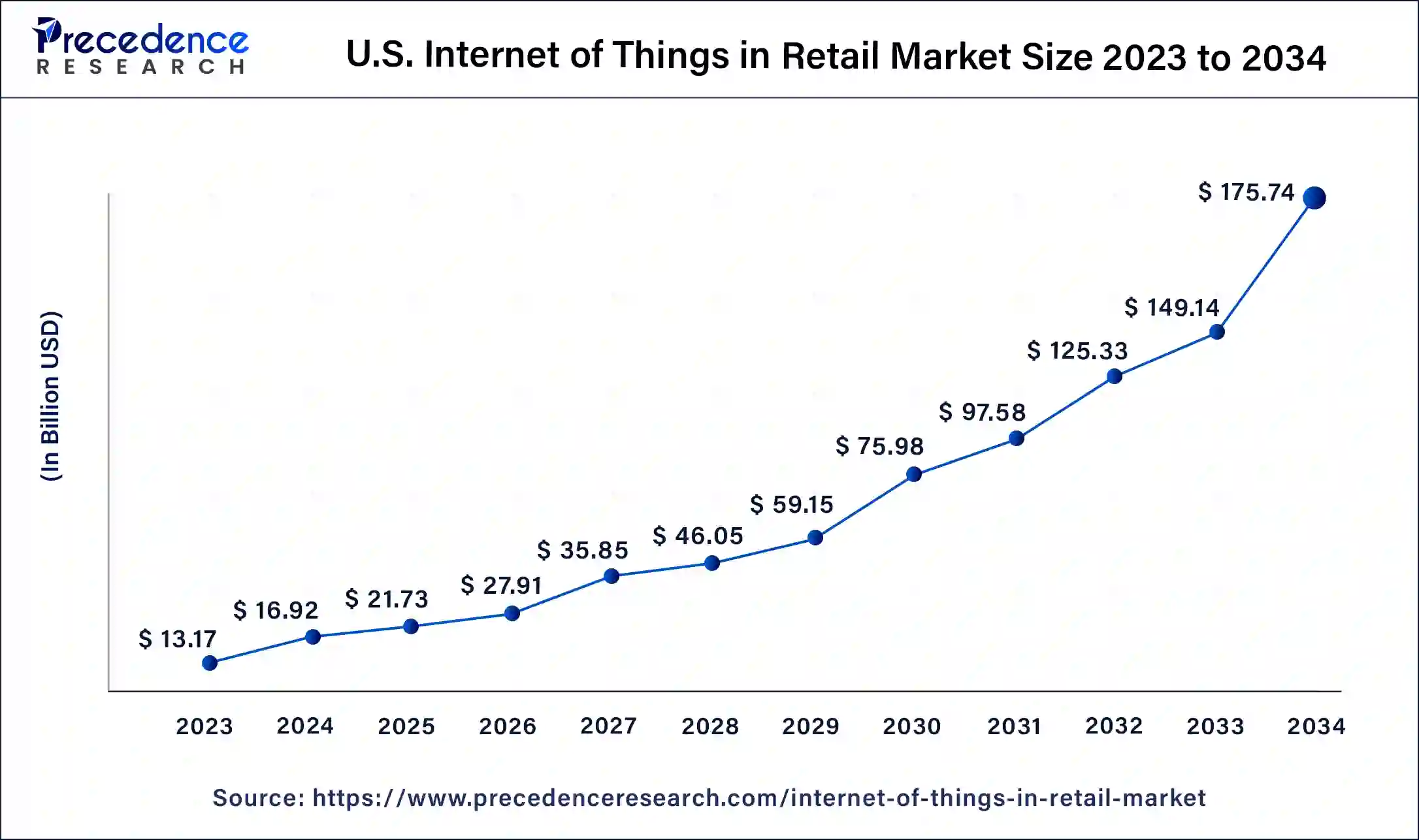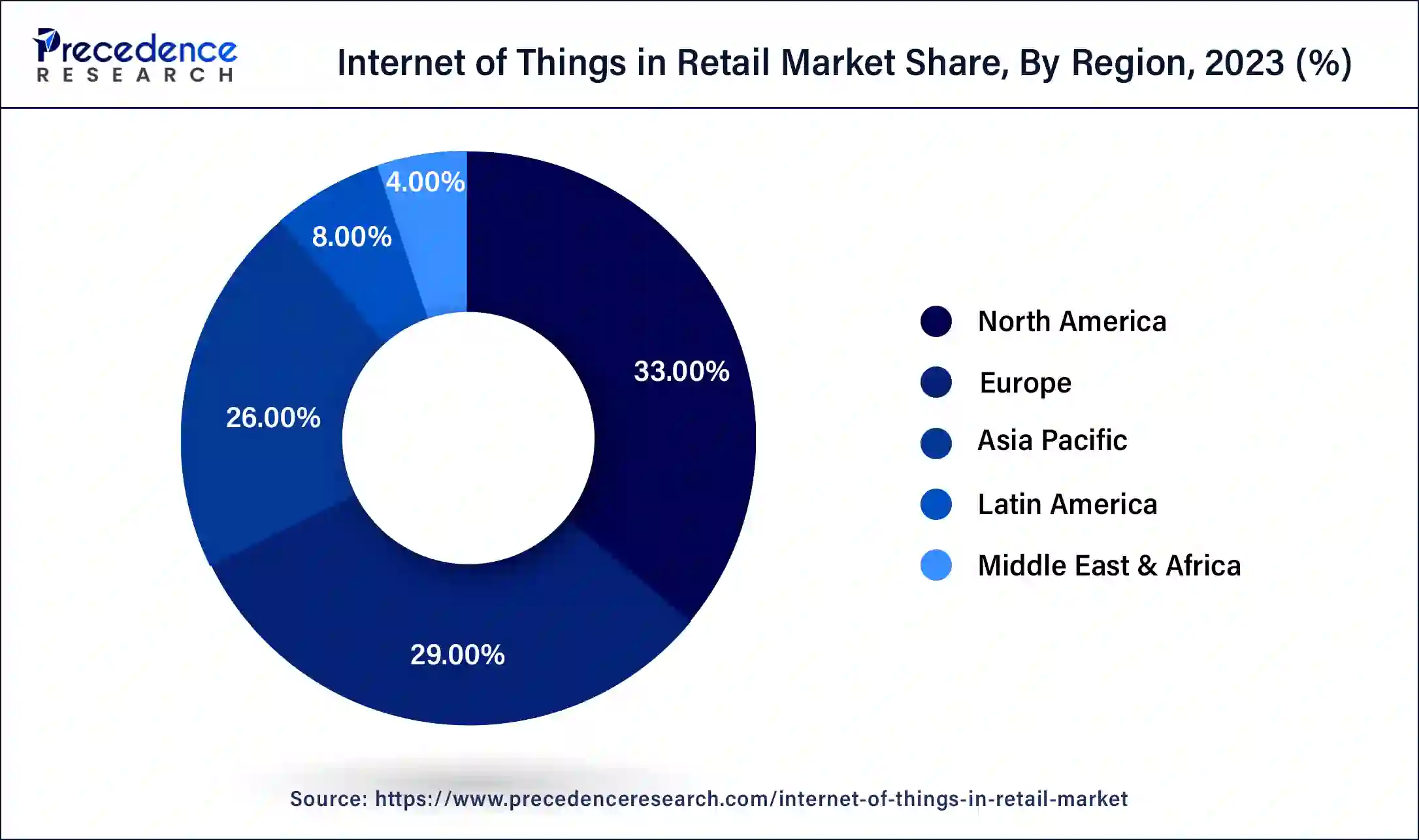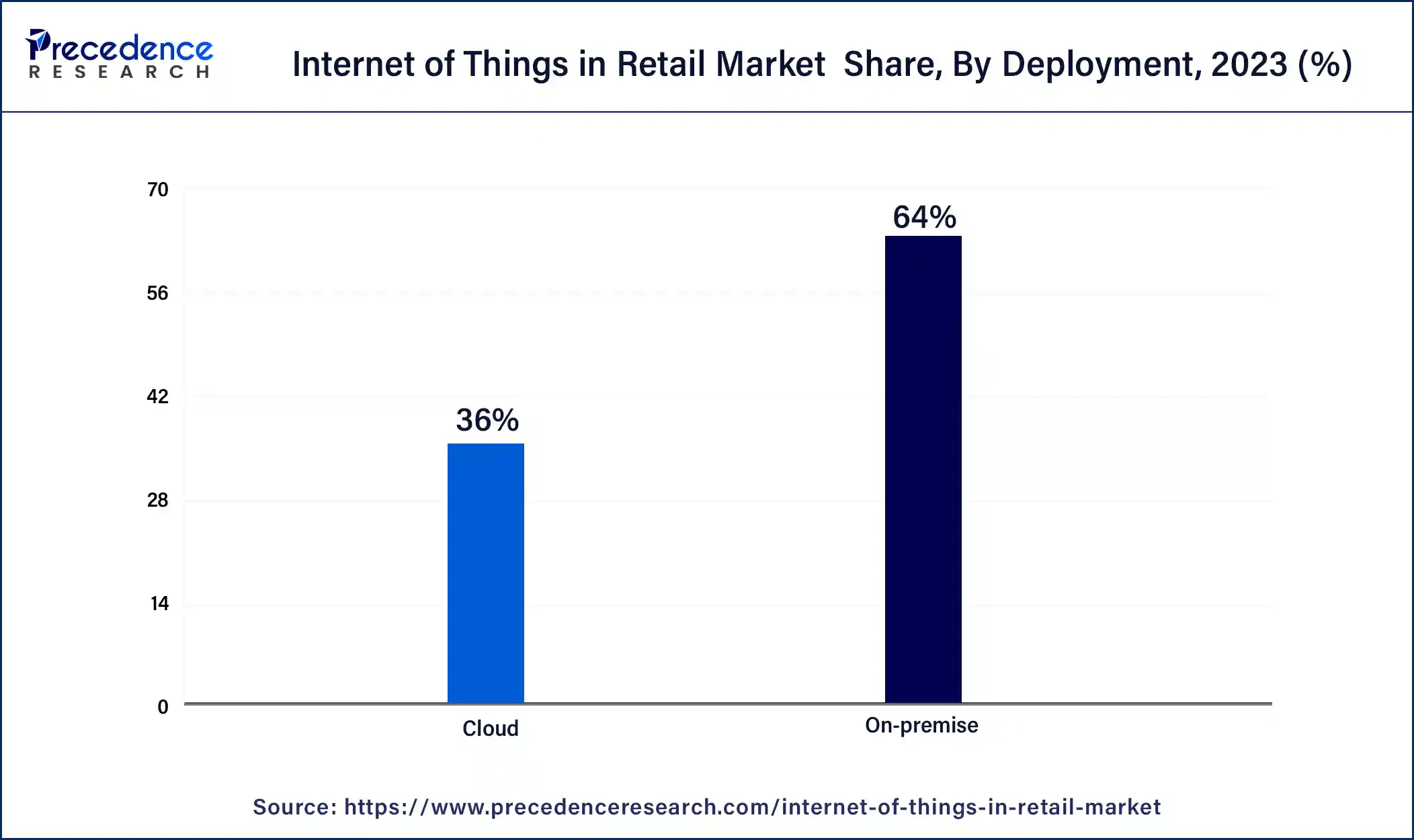January 2025
Internet of Things in Retail Market (By Deployment: On-premise, Cloud; By Technology: Bluetooth Low Energy, Near Field Communication, ZigBee, Other Technologies; By Component: Hardware, Platform, Services; By Application: Operations Management, Customer Management, Customer Management, Asset Management, Advertising and Marketing, Others) - Global Industry Analysis, Size, Share, Growth, Trends, Regional Outlook, and Forecast 2024-2034
The global internet of things in retail market size was USD 56.92 billion in 2023, calculated at USD 72.97 billion in 2024, and is expected to reach around USD 743.76 billion by 2034, expanding at a CAGR of 26.1% from 2024 to 2034.

The U.S. internet of things in retail market size was valued at USD 13.17 billion in 2023 and is estimated to reach around USD 175.74 billion by 2034, growing at a CAGR of 26.4% from 2024 to 2034.

North America has held the largest revenue share 33% in 2023. North America's commanding position in the market is a result of its rapid and extensive embrace of Internet of Things (IoT) innovations. The region benefits from cutting-edge infrastructure, a well-established IT ecosystem, and a fervent dedication to technological advancement, creating an ideal landscape for IoT integration across diverse sectors. Moreover, substantial investments in IoT research and development, fortified by governmental support, have propelled North America to a prominent stance in the global IoT market arena. The presence of numerous influential IoT solution providers and a tech-savvy populace further reaffirm the region's leadership in the worldwide IoT market.

Asia-Pacific is estimated to observe the fastest expansion. Asia-Pacific's significant market share is attributed to several compelling factors. The region's large and swiftly growing population presents a fertile ground for IoT proliferation. Governments and businesses are actively pouring investments into IoT infrastructure, particularly in sectors like manufacturing, agriculture, and healthcare. Furthermore, the region enjoys a tech-savvy consumer base, spurring the demand for IoT-driven offerings. Asia-Pacific's robust manufacturing industry and supply chain operations stand to gain from IoT's efficiency enhancements. These converging dynamics establish Asia-Pacific as a formidable presence in the global IoT market, reflecting its substantial market share.
The internet of things in retail market pertains to the incorporation of intelligent, interconnected devices and sensors within retail establishments, aiming to elevate operational efficiency and enrich customer interactions. IoT technology facilitates the gathering and real-time analysis of data, streamlining inventory management, crafting personalized shopping journeys, and seamlessly uniting online and offline shopping realms. Its prominence has surged owing to its capacity to stimulate sales, curtail expenses, and adapt to changing consumer preferences. Within the IoT in retail market, IoT gadgets and solutions are being implemented to revolutionize traditional retail, morphing it into a digitally linked, data-centric industry.
The Internet of things (IoT) has rapidly transformed the retail industry, ushering in an era of enhanced customer experiences and operational efficiency. The IoT in retail market is projected to witness substantial growth as it capitalizes on several key trends and drivers.
IoT technology has enabled retailers to create smart stores, enhancing customer engagement through personalized shopping experiences. Smart shelves equipped with RFID tags and sensors help monitor inventory in real-time, reducing out-of-stock situations. In addition, IoT-driven data analytics provide valuable insights into customer behavior, enabling retailers to optimize store layouts and product placements for maximum sales.
One of the primary growth drivers in the IoT in retail market is the increasing demand for seamless, omnichannel shopping experiences. IoT devices facilitate the integration of online and offline retail, offering consumers a consistent journey across various touch points. Moreover, the COVID-19 pandemic has accelerated the adoption of IoT in retail as contactless shopping options and curbside pickup became essential services for safety-conscious shoppers.
The proliferation of connected devices and the expansion of 5G networks play a pivotal role in the growth of IoT in retail. These technologies enable faster and more reliable data transmission, supporting the real-time communication between devices and systems. Furthermore, the decreasing cost of IoT sensors and devices makes it more accessible for retailers of all sizes to implement IoT solutions, further fueling market growth.
Despite the promising prospects, the IoT in retail market faces several challenges. Data security and privacy concerns are paramount, as the vast amount of customer data collected by IoT devices requires stringent protection against cyber threats. Additionally, interoperability issues among various IoT platforms and devices can hinder seamless integration and limit the full potential of IoT in the retail sector.
For businesses, the IoT in Retail Market offers numerous opportunities for innovation and revenue generation. Retailers can leverage IoT to automate inventory management, reduce energy consumption through smart lighting and HVAC systems, and create more targeted marketing campaigns based on real-time customer data. Collaborations with IoT solution providers and investment in IoT infrastructure are key steps for retailers to tap into these exciting opportunities and remain competitive in the evolving retail landscape.
In conclusion, the IoT in retail market is experiencing significant growth driven by trends such as smart stores and omnichannel experiences, as well as factors like the proliferation of connected devices and 5G networks. While challenges like data security and interoperability persist, the industry's potential for enhanced customer engagement, operational efficiency, and innovation presents compelling business opportunities for retailers willing to embrace IoT technologies.
| Report Coverage | Details |
| Market Size by 2034 | USD 743.76 Billion |
| Market Size in 2023 | USD 56.92 Billion |
| Market Size in 2024 | USD 72.97 Billion |
| Growth Rate from 2024 to 2034 | CAGR of 26.1% |
| Largest Market | North America |
| Base Year | 2023 |
| Forecast Period | 2024 to 2034 |
| Segments Covered | By Deployment, By Technology, By Component, and By Application |
| Regions Covered | North America, Europe, Asia-Pacific, Latin America, and Middle East & Africa |
Omnichannel integration stands as a potent catalyst propelling substantial market expansion within the retail sector. This strategy hinges on the seamless amalgamation of diverse shopping avenues, encompassing physical brick-and-mortar stores, e-commerce platforms, mobile applications, and social media channels.
The core objective is to furnish customers with a harmonized, unbroken, and coherent shopping experience. Foremost, modern consumers ardently seek versatility and convenience in shopping. They desire the ability to research products online, effectuate purchases in physical establishments, and execute returns via digital interfaces, all while anticipating uniform pricing, promotions, and personalized product suggestions across every channel.
Omnichannel integration satisfactorily addresses these expectations, amplifying customer contentment and commitment. Moreover, retailers leveraging omnichannel strategies gain a competitive edge. They can reach a broader audience and tap into new markets, all while capturing valuable data on customer behavior and preferences. This data-driven approach empowers retailers to refine their marketing efforts, optimize inventory management, and tailor their product offerings.
Additionally, the COVID-19 pandemic accelerated the importance of omnichannel strategies as consumers sought safe and convenient shopping options. Retailers with robust omnichannel capabilities, such as curbside pickup and contactless payment, were better equipped to meet changing consumer needs. In essence, omnichannel integration is not just a growth driver but a necessity in today's retail landscape. It aligns with evolving consumer expectations, offers competitive advantages, and ensures retailers remain adaptable and relevant in an increasingly digital world.
The uncertainty surrounding costs and return on investment (ROI) stands as a significant restraint impeding the growth of the omnichannel integration market. Implementing omnichannel strategies requires substantial investments in technology, infrastructure, staff training, and ongoing maintenance. These upfront costs can be daunting for businesses, especially smaller retailers with limited resources. Moreover, the timeline for realizing ROI in omnichannel initiatives can be protracted, making it challenging to justify the initial expenses. ROI uncertainty arises from various factors, including the evolving nature of consumer behavior and the rapid pace of technological change.
Predicting how quickly customers will adapt to new omnichannel offerings and estimating the precise impact on sales and customer loyalty is complex and uncertain. Additionally, the competitive landscape complicates ROI calculations. As more businesses adopt omnichannel strategies, achieving a distinct competitive advantage becomes harder, potentially delaying ROI. Overall, the ambiguity surrounding costs and ROI can deter businesses from fully embracing omnichannel integration, inhibiting the market's growth potential.
Inventory optimization is creating significant opportunities in the market by revolutionizing how retailers manage their stock. Through the deployment of Internet of Things (IoT) sensors, RFID technology, and advanced data analytics, businesses gain real-time visibility into their inventory, enabling them to make informed decisions and enhance their operations. This newfound precision leads to reduced stockouts, minimized overstock situations, and more efficient supply chain management, ultimately translating into substantial cost savings and improved profitability.
Moreover, inventory optimization also allows retailers to meet the evolving demands of today's consumers who expect products to be readily available when and where they want them. By ensuring products are in stock and accessible, retailers can enhance customer satisfaction and loyalty, driving increased sales and market share. Additionally, retailers can reduce the need for costly manual inventory checks and streamline restocking processes, freeing up resources and time for other value-added activities. This strategic advantage positions businesses to thrive in a highly competitive retail landscape and capitalize on emerging market trends.
Impact of COVID-19:
The COVID-19 pandemic accelerated the adoption of IoT in the retail market. Retailers embraced IoT solutions like contactless payments, occupancy monitoring, and curbside pickup to address health and safety concerns, transforming the shopping experience. IoT helped retailers adapt to shifting consumer behaviors, such as increased online shopping and the demand for seamless omnichannel experiences. It also aided in real-time inventory management, reducing supply chain disruptions. While the pandemic presented challenges, it underscored the essential role of IoT in ensuring business continuity, enhancing safety, and meeting evolving customer expectations, driving its continued growth in the retail sector.
According to the deployment, the on-premise sector has held 64% revenue share in 2023. The On-premise segment holds a substantial market share due to its advantages in data control and security. Many businesses, particularly in sensitive industries like finance and healthcare, prefer on-premise IoT solutions to maintain direct oversight and compliance.
On-premise solutions offer greater control over data storage, processing, and security protocols, assuaging concerns about data breaches and privacy. They also ensure consistent availability, reducing reliance on external networks. While cloud-based solutions offer scalability and cost-efficiency, the On-premise segment remains a preferred choice for organizations valuing stringent data control and regulatory compliance, contributing to its significant market share.

The cloud sector is anticipated to expand at a significantly CAGR of 31.5% during the projected period due to its scalability, adaptability, and economic advantages. Cloud-based IoT solutions excel in seamlessly integrating with diverse devices and sensors, enabling the swift collection and analysis of real-time data. With minimal on-site infrastructure demands, they curtail initial expenditures and maintenance burdens. Furthermore, cloud platforms offer secure and centralized data storage, ensuring efficient data governance and accessibility. These features, coupled with their ease of deployment and expandability, make cloud-based IoT solutions exceptionally appealing to enterprises, solidifying their commanding growth within the market.
Based on the technology, near field communication is anticipated to hold the largest market share of 32% in 2023. Near Field Communication (NFC) holds a significant share in the IoT in Retail market due to its versatility and convenience. NFC technology allows secure, short-range communication between devices, facilitating contactless payments, customer engagement, and inventory management.
It enhances the shopping experience by enabling quick and seamless transactions through mobile wallets and smart cards. NFC's adaptability to various retail applications, its ease of use, and its integration into smartphones have made it a preferred choice for retailers aiming to provide contactless, personalized, and efficient services, thus solidifying its major share in the market.
On the other hand, the Bluetooth low energy sector is projected to grow at the fastest rate over the projected period. Bluetooth Low Energy (BLE) holds a major growth in the market due to its efficiency and versatility. BLE technology offers a balance between power consumption and connectivity, making it ideal for IoT devices in the retail sector. It enables retailers to deploy a wide range of sensors and beacons that facilitate tasks like indoor navigation, proximity marketing, and inventory tracking without draining batteries quickly. This efficiency, coupled with its compatibility with smartphones and tablets, has made BLE a preferred choice for implementing IoT solutions, thus capturing a significant growth in the IoT in retail market.
The operations management segment held the largest revenue share of 31% in 2023. Operations management holds a significant share in the market because it plays a central role in optimizing efficiency, reducing costs, and enhancing customer experiences. By leveraging IoT technologies, retailers can automate inventory management, monitor equipment health, and streamline logistics, resulting in improved operational efficiency. This segment helps retailers adapt to changing consumer expectations, such as seamless omnichannel integration and real-time inventory tracking. Additionally, IoT-driven data analytics empower informed decision-making, making operations management a crucial driver of competitive advantage, cost savings, and overall success in the dynamic retail landscape.
The customer management is anticipated to grow at a significantly faster rate, registering a CAGR of 32.9% over the predicted period. The customer management segment holds substantial growth in the IoT in retail market because it addresses critical retail challenges. IoT solutions enable retailers to gather valuable customer data across various touchpoints, aiding in personalization, targeted marketing, and improved customer experiences.
With IoT, retailers can offer tailored recommendations, streamline checkout processes, and track customer preferences. This enhances customer engagement, loyalty, and ultimately drives sales. Furthermore, the COVID-19 pandemic accelerated the demand for contactless shopping and omnichannel experiences, further boosting the growth of IoT in customer management within the retail sector.
The hardware sector has generated a revenue share of 46.1% in 2023. The dominant share of the hardware segment in the IoT market stems from its fundamental role in facilitating IoT implementations. Hardware components, such as sensors, RFID tags, and connectivity devices, serve as the critical building blocks for real-time data acquisition in the physical realm. This data forms the essential foundation for diverse IoT applications, including inventory management and smart retail systems.
Moreover, the expansion of IoT within the retail sector hinges significantly on these hardware elements, as they constitute the infrastructure necessary for deploying and operationalizing IoT solutions. Consequently, the hardware segment wields substantial influence and importance within the IoT market.
The services sector is anticipated to grow at a significantly faster rate, registering a CAGR of 30.8% over the predicted period. The dominance of the services segment in the market can be attributed to its fundamental role in facilitating the deployment and management of Internet of Things (IoT) solutions across various sectors. Service providers bring their specialized knowledge to the table, aiding in the formulation, integration, upkeep, and data analysis related to IoT technologies.
Furthermore, these providers offer tailor-made solutions to address the specific demands of industries like healthcare, manufacturing, and logistics, ensuring a bespoke approach. Their holistic services, coupled with ongoing assistance, establish them as indispensable partners for organizations seeking to effectively implement and maximize the potential of IoT, resulting in their substantial market share.
Segments Covered in the Report:
By Deployment
By Technology
By Component
By Application
By Geography
For inquiries regarding discounts, bulk purchases, or customization requests, please contact us at sales@precedenceresearch.com
No cookie-cutter, only authentic analysis – take the 1st step to become a Precedence Research client
January 2025
December 2024
December 2024
March 2025